Sam McVey was knows as "L'Idole de Paris." And while he and other black fighters were adored in Paris for their pugilistic abilities, Europe was also becoming more interested in "All-in" fighting, which was what we'd call MMA today.

There are two tales of Sam McVey being contracted to put his boxing skills up to the test against Ju-Jitsu experts.
The first was currently displaying his skills in London. He was Tano Matsuda, a man billed as "The Japanese World's Champion of Ju-Jitsu".
Tano Matsuda arrived the night before the fight and immediately went to his hotel, sending a representative to go over the rules.
The Rules:
McVey has second thoughts:
As the fight got closer, McVey began to get more and more worried, despite the amount of money that he would make. Part of the reason he became so worried is because of Sam Langford, who was also present in Paris, playing with his head
Though McVey seemed to gain confidence when he watched his opponent climb into the ring.
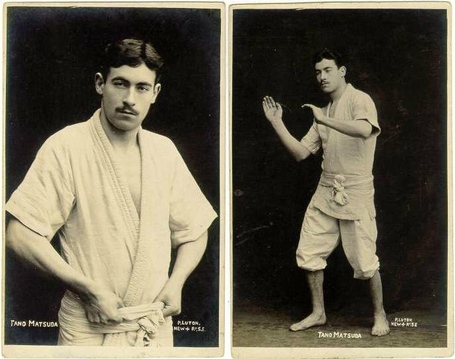
The fight
"The gong sounded and Tano rushed McVea, who, still worried by Langford's warning and remembering Duke's advice, let loose with a fearsome left hook which caught Matsuda squarely on the jaw, dropping him to the canvas. Since striking on the ground was allowed, McVea followed up but only lightly as his opponent was finished. The referee quickly stopped the action, and in only eight seconds it was over."
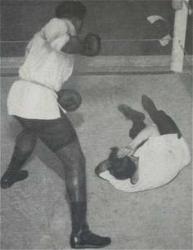
McVey received his money and never thought of entertaining another match against a Ju-Jitsu expert.
But later....he would accept one more fight. And this time, against a TRUE Ju-Jitsu Master....

There are two tales of Sam McVey being contracted to put his boxing skills up to the test against Ju-Jitsu experts.
The first was currently displaying his skills in London. He was Tano Matsuda, a man billed as "The Japanese World's Champion of Ju-Jitsu".
Tano Matsuda arrived the night before the fight and immediately went to his hotel, sending a representative to go over the rules.
The Rules:
The contest was to be held under the "traditional regulations of boxing against jiu-jitsu fighting" which apparently were common enough that there was little debate as to what they involved. McVea would not have to wear a jacket or vest, but would wear boxing gloves. He would also be permitted to strike his opponent on the ground, while the only tactic forbidden to Tano was gouging the eyes. Each round would last three minutes and the match would continue until one of the men was unable to stand within a ten-count, conceded defeat, or the referee determined they were unfit to continue. In any case, It was also agreed by all parties that any and all decisions by Reichel [the referee] would be final.
As the fight got closer, McVey began to get more and more worried, despite the amount of money that he would make. Part of the reason he became so worried is because of Sam Langford, who was also present in Paris, playing with his head

Sam was guaranteed 2,000 pounds win, lose or draw. He thought it would be easy money until Langford said, "Lord almighty, Sambo, he'll snap youse bones like matches."
These words from a tough little man like Langford put fear into McVey. He entered the ring ashen grey. He worried off nearly a stone in the few days before the contest. I [trainer, Duke Mullins] told him that his only chance was to get the Japanese with the first punch.
"If you miss," I added, "he'll be throwing your arms and legs to the audience in half a minute."
"Lord, save me," groaned McVey.
These words from a tough little man like Langford put fear into McVey. He entered the ring ashen grey. He worried off nearly a stone in the few days before the contest. I [trainer, Duke Mullins] told him that his only chance was to get the Japanese with the first punch.
"If you miss," I added, "he'll be throwing your arms and legs to the audience in half a minute."
"Lord, save me," groaned McVey.

Tano Matsuda wasn't the dreaded Japanese champion he'd be billed as but instead "he was a pathetic english man, skinny, and emaciated." This was soon followed by another surprise, as Baxter now demanded that each round be only two minutes in duration, and, more importantly, that McVea don an uwagi ju-jitsu jacket. There was a huge expression of outrage from the crowd, but both Baxter and Tano refuse to concede on this demand. Sam eventually gave in, and the match was ready to proceed.
"The gong sounded and Tano rushed McVea, who, still worried by Langford's warning and remembering Duke's advice, let loose with a fearsome left hook which caught Matsuda squarely on the jaw, dropping him to the canvas. Since striking on the ground was allowed, McVea followed up but only lightly as his opponent was finished. The referee quickly stopped the action, and in only eight seconds it was over."

It was then that the crowd and the management of the Marigny became painfully aware that they'd been had, for Tano Matsuda was not only not Japanese, but not much of a jiu-jitsu master either. (In fact his real name was John Payton, and it seems likely that he'd taken up jiu-jitsu as a student of Mitsuyo Maeda only as recently as the year before.)
Scandal. The furious crowd jumped on the stage, invaded the ring, determined to beat up the impertinent and deceitful Tano. He had disappeared, thankfully for him. Or rather no! With dexterity he had gone to change backstage and mingled with the crowd of protesters. If I recall correctly, he was the one clamoring with the most ardor and violence.
Scandal. The furious crowd jumped on the stage, invaded the ring, determined to beat up the impertinent and deceitful Tano. He had disappeared, thankfully for him. Or rather no! With dexterity he had gone to change backstage and mingled with the crowd of protesters. If I recall correctly, he was the one clamoring with the most ardor and violence.
"No, not for me Dook," he said. "What if I missed?"
But later....he would accept one more fight. And this time, against a TRUE Ju-Jitsu Master....

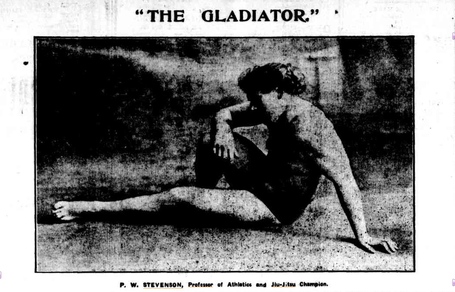
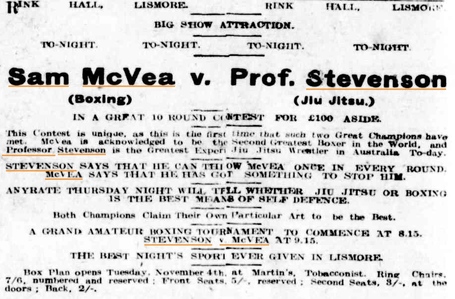
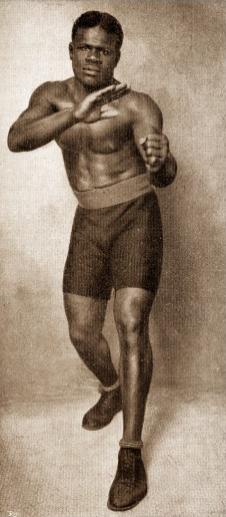


Comment